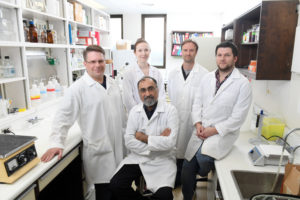 “Currently, there are no effective means to treat Alzheimer’s disease or definitely diagnose this condition during life. We have recently shown that the protein, butyrylcholinesterase (BChE) typically presents in high levels in the Alzheimer’s disease brain and is a very specific marker for the disease. We have developed a radiotracer for brain imaging that targets the BChE protein. The brain imaging method developed in our lab may enhance the accuracy and timely detection of Alzheimer’s disease, providing the best opportunity to evaluate emerging Alzheimer’s therapies for timely disease treatment.” Dr. Sultan Darvesh
“Currently, there are no effective means to treat Alzheimer’s disease or definitely diagnose this condition during life. We have recently shown that the protein, butyrylcholinesterase (BChE) typically presents in high levels in the Alzheimer’s disease brain and is a very specific marker for the disease. We have developed a radiotracer for brain imaging that targets the BChE protein. The brain imaging method developed in our lab may enhance the accuracy and timely detection of Alzheimer’s disease, providing the best opportunity to evaluate emerging Alzheimer’s therapies for timely disease treatment.” Dr. Sultan Darvesh
Alzheimer’s disease is the most common cause of dementia. And the number of people impacted is on the rise.
For over 30 years, scientists have been searching for an intervention that could modify the course of Alzheimer’s disease, improve the experiences of those living with it, and reverse its social and economic impacts. Despite this, a definitive diagnosis can still only occur after death.
According to Dr. Sultan Darvesh – who leads the Maritime Brain Tissue Bank and is a researcher within the Canadian Consortium on Neurodegeneration in Aging – it’s only through a post-mortem brain tissue exam that scientists can appreciate the full extent of amyloid-beta (Aβ) plaques and tau neurofibrillary tangles in the brain of someone who has died from Alzheimer’s disease, and these plaques and tangles have long been the hallmarks of the disease.
In Alzheimer’s disease, the neocortex – the part of the brain concerned with thinking – is one of the first areas where Aβ pathology accumulates. A cascading effect follows. Aβ spreads to other regions of the brain important in memory, other cognitive functions, and behavior. As Darvesh explains, the progression of Aβ deposits occurs in an ‘outward-in’ direction, “making the cerebral cortex the prime region to target to detect Alzheimer’s disease pathology early.”
To date, scientists have identified Aβ and tau tangles through brain imaging scans by developing injectable dyes (used as biomarkers) that are sensitive enough to only bind to these deposits to illuminate the pathology. Their efforts at early diagnosis have been frustrated by the fact that Aβ and tau can also be found in the brains of up to 30% of cognitively normal older adults. Knowing this, Darvesh and his team have sought out an alternative biomarker, butyrylcholinesterase (BChE).

Why BChE? In a recent study, Darvesh and his team compared deposits of Aβ plaque and BChE in postmortem brains from cognitively normal older adults and those with Alzheimer’s disease. Their objective was to discover whether BChE can serve as a therapeutic target, and whether it is a sensitive enough marker of the disease to use in brain scans to diagnose Alzheimer’s disease early, during an individual’s lifetime.
The team has found that in other dementias – Corticobasal degeneration, Fronto-temporal dementia, dementia with Lewy Bodies, and Vascular dementia – there are no increases in levels of BChE. This suggests BChE only associates with the Aβ plaques and tau tangles in Alzheimer’s disease brain tissue. Importantly, BChE-associated pathology was virtually absent in the brain tissues of the cognitively normal subjects with Aβ plaques and tau tangles who were studied.
This means that BChE can distinguish plaques associated with Alzheimer’s disease from those found in cognitively normal brains.
The team has also confirmed this is true in Alzheimer’s disease mouse models. In fact, when the BCHE gene is silenced from an Alzheimer’s disease mouse model, there is a corresponding reduction in Aβ plaque deposits. This suggests that not only is BChE unique to Alzheimer’s disease, it may also be involved in the accumulation of the pathology that leads to dementia, and the clinical presentation of Alzheimer’s disease.
In a second study published this year, Darvesh’s group were able to show that a radiotracer they have developed to target BChE for brain imaging was able to distinguish Alzheimer’s disease brains from healthy brains in a mouse model of the disease.
In Darvesh’s words, “These results show that BChE may serve as a more specific Alzheimer’s disease biomarker than Aβ, and so may be better able to diagnose Alzheimer’s disease when used as a diagnostic target in brain imaging.”
Further testing and refinement of these promising BChE brain imaging radiotracers is ongoing, with the goal that such agents advance to clinical trials over the next 5 years.
